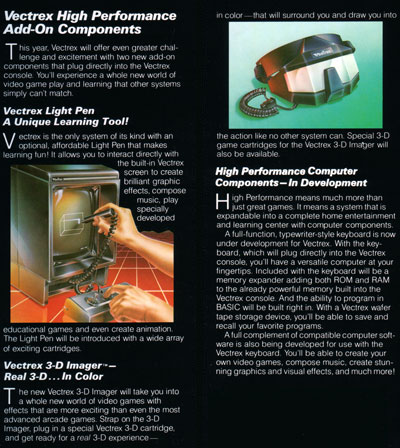
 |
Search | FAQ | US Titles | UK Titles | Memories | VaporWare | Digest | |||||||
| GuestBook | Classified | Chat | Products | Featured | Technical | Museum | ||||||||
| Downloads | Production | Fanfares | Music | Misc | Related | Contact | ||||||||
| CED in the History of Media Technology | ||||||||||||||

The GCE Vectrex Arcade System was introduced in June 1982 at the Summer CES show and became available for purchase at $199 later that year. This system was noteworthy for using vector graphics to display images on the screen. Vector graphics employ X,Y positioning to draw wire frame images and are in contrast to the raster graphics used on practically every other consumer display in which continuous scan lines draw the image. The advantage of vector graphics is that they were fast in the 1982 time frame, but this display technology was not well suited for drawing text or solid objects.
The Vectrex was a black & white system, but achieved color by using overlays on the screen in much the same way as the Magnavox Odyssey and some of the early full-size video arcade games. In 1984 GCE introduced the Light Pen and 3-D Imager pictured in the above advertisement, and used the name Vectrex Graphic Computer System with plans to provide a keyboard with BASIC and a wafer tape storage device. The head-mounted 3-D imager was unique in that it achieved both 3D and color images by putting a spinning wheel in front of the viewer's eyes that contained red, green, blue and opaque black sections. The 3D color games were synchronized with this wheel which is similar to the spinning wheels used on some early B&W TV's to achieve color.
The Vectrex did not survive the great videogame crash of 1984, so the computer keyboard and drive were never released. But in a way the basic design of the machine did survive in the form of the Macintosh 128K which made the display a raster after rotating it 90 degrees and used the same internal component board layout as the Vectrex.